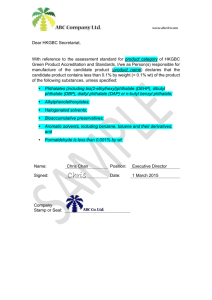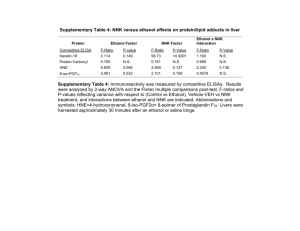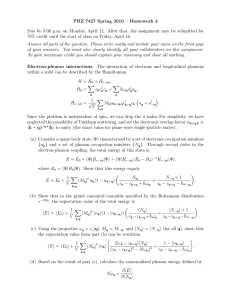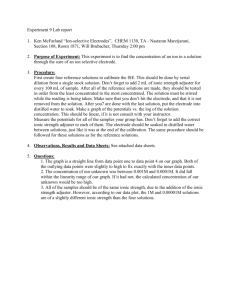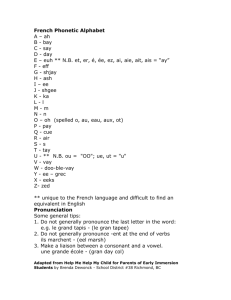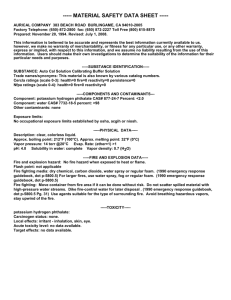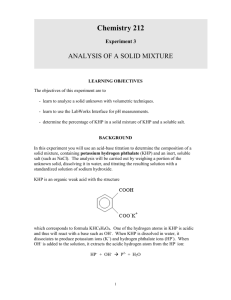Gran Plot Lab
advertisement
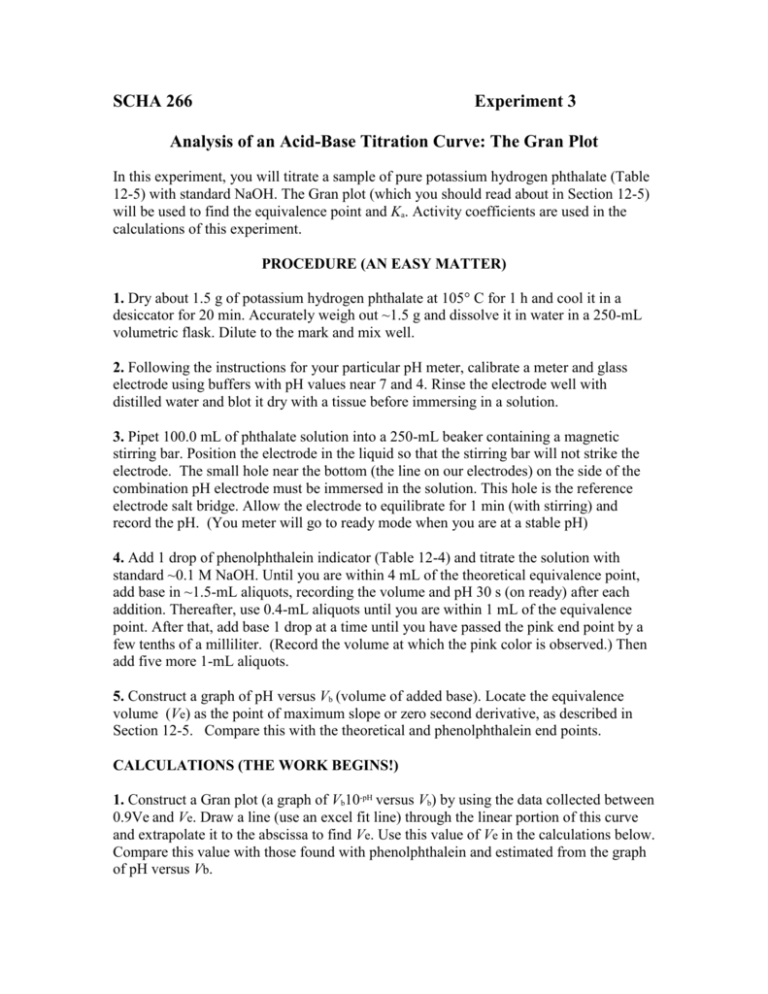
SCHA 266 Experiment 3 Analysis of an Acid-Base Titration Curve: The Gran Plot In this experiment, you will titrate a sample of pure potassium hydrogen phthalate (Table 12-5) with standard NaOH. The Gran plot (which you should read about in Section 12-5) will be used to find the equivalence point and Ka. Activity coefficients are used in the calculations of this experiment. PROCEDURE (AN EASY MATTER) 1. Dry about 1.5 g of potassium hydrogen phthalate at 105° C for 1 h and cool it in a desiccator for 20 min. Accurately weigh out ~1.5 g and dissolve it in water in a 250-mL volumetric flask. Dilute to the mark and mix well. 2. Following the instructions for your particular pH meter, calibrate a meter and glass electrode using buffers with pH values near 7 and 4. Rinse the electrode well with distilled water and blot it dry with a tissue before immersing in a solution. 3. Pipet 100.0 mL of phthalate solution into a 250-mL beaker containing a magnetic stirring bar. Position the electrode in the liquid so that the stirring bar will not strike the electrode. The small hole near the bottom (the line on our electrodes) on the side of the combination pH electrode must be immersed in the solution. This hole is the reference electrode salt bridge. Allow the electrode to equilibrate for 1 min (with stirring) and record the pH. (You meter will go to ready mode when you are at a stable pH) 4. Add 1 drop of phenolphthalein indicator (Table 12-4) and titrate the solution with standard ~0.1 M NaOH. Until you are within 4 mL of the theoretical equivalence point, add base in ~1.5-mL aliquots, recording the volume and pH 30 s (on ready) after each addition. Thereafter, use 0.4-mL aliquots until you are within 1 mL of the equivalence point. After that, add base 1 drop at a time until you have passed the pink end point by a few tenths of a milliliter. (Record the volume at which the pink color is observed.) Then add five more 1-mL aliquots. 5. Construct a graph of pH versus Vb (volume of added base). Locate the equivalence volume (Ve) as the point of maximum slope or zero second derivative, as described in Section 12-5. Compare this with the theoretical and phenolphthalein end points. CALCULATIONS (THE WORK BEGINS!) 1. Construct a Gran plot (a graph of Vb10-pH versus Vb) by using the data collected between 0.9Ve and Ve. Draw a line (use an excel fit line) through the linear portion of this curve and extrapolate it to the abscissa to find Ve. Use this value of Ve in the calculations below. Compare this value with those found with phenolphthalein and estimated from the graph of pH versus Vb. 2. Compute the slope of the Gran plot and use Equation 12-5 to find Ka for potassium hydrogen phthalate as follows: The slope of the Gran plot is –KaHP-/P2-. In this equation, P2- is the phthalate anion and HP- is monohydrogen phthalate. Because the ionic strength changes slightly as the titration proceeds, so also do the activity coefficients. Calculate the ionic strength at 0.95Ve, and use this "average" ionic strength to find the activity coefficients. EXAMPLE Calculating Activity Coefficients Find HP- and P2- at 0.95 Ve in the titration of 100.0 mL of 0.020 0 M potassium hydrogen phthalate with 0.100 M NaOH. Solution The equivalence point is 20.0 mL, so 0.95Ve, = 19.0 mL. The concentrations of H+ and OH- are negligible compared with those of K+, Na+, HP-, and P2-, whose concentrations are [K] 100/119)*(0.0200) 0.0168 M [Na] 100/119)*(0.100) 0.0160 M [HP ] 0.050)(100/119)*(0.0200) 0.00084 M [P2] 0.95)(100/119)*01(0.0200) 0.0160 M The ionic strength is = 0.5cizi2 = 1/2 [ (0.016 8) . 12 + (0.016 0) . 12 + (0.000 84) . 12 + (0.016 0) . 22 ] = 0.048 8 M To estimate P2- and HP- at µ = 0.048 8 M, interpolate in Table 8-1. In this table, we find that the hydrated radius of P2- —phthalate, C6H4(CO2 - )2—is 600 pm. The size of HP- is not listed, but we will suppose that it is also 600 pm. An ion with charge ±2 and a size of 600 pm has = 0.485 at µ = 0.05 M and = 0.675 at µ = 0.01 M. Interpolating between these values, we estimate P2- = 0.49 when µ = 0.048 8 M. Similarly, we estimate HP- = 0.84 at this same ionic strength. 3. From the measured slope of the Gran plot and the values of HP- and P2-, calculate pKa. Then choose an experimental point near 1/3 Ve and one near 2/3 Ve. Use Equation 10-18 to find pKa with each point. (You will have to calculate [P2-], [HP-], P2-, and HPat each point.) Compare the average value of pKa from your experiment with pK2 for phthalic acid listed in Appendix G.
